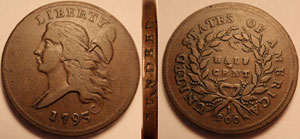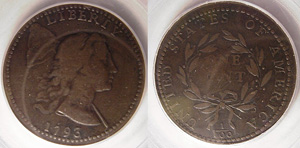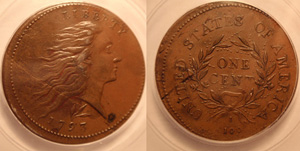The Lure of Curiously Historic Coins Minted from Copper
 Antique copper coins.
Antique copper coins.Photograph courtesy of Shawn Yancey
Shawn Yancey took his first introduction to coin collecting through his grandfather, a barber who gathered albums from the coins his clients used to pay him for haircuts and a clean shave. Yancey still has the first coin his grandfather gave him, a 1922 silver Peace Dollar.
"It's not worth very much, maybe $20 or so, but to me, it is priceless," he says, now as a copper numismatist living in Springfield, MO.
Over the years, Yancey grew his enduring penchant for coin collecting into a thriving business while his former job in heavy duty truck sales began to take a hard hit with tumbling economic conditions.
"The most rewarding thing about coin collecting is that I have been able to turn my passion for coins into a business that supports my family," he says.
Today, Yancey sells rare coins through his website, Earlycoppercoins.com, specializing in early American coppers, or large copper cents and half-cents minted between 1793 and 1857.
 Antique copper coins.
Antique copper coins.Photograph courtesy of Shawn Yancey
He estimates that he has purchased and sold more than 10,000 of these early coppers to other like-minded coin enthusiasts in the last 15 years.
Estate auctions, antique shops, and from other collectors and dealers are the main routes Yancey uses for discovering the coins he adds to his supply.
"I have been doing this long enough now that I feel like my hand is in every cookie jar and under every rock," he admits.
As a member of the Early American Coppers, an organization of dedicated coin collectors which Yancey describes as "infected with the incurable 'early copper syndrome,’” traveling across the country to different conventions and regional meetings every year is a big part of supporting his collections, sales, and passion in copper coin-speak.
Networking with other collectors has been an invaluable benefit to Yancey in that his now well-honed knowledge of how to grade the condition of genuine coins and spot insidious fakes.
One of the strongest details of the mystique associated with copper coins comes from the fact that they were the first official coins produced by the U.S. Mint.
These half cents and large cents were struck by hand on blank copper discs known as planchets. Since the coins were struck by hand and without modern conveniences such as electricity, mistakes and anomalies were commonplace—but this makes each example unique and even more curious in contemporary terms.
 Antique copper coins.
Antique copper coins.Photograph courtesy of Shawn Yancey
"I love the fact that copper coins can have so many looks," Yancey says. "They can range from the full, bold mint-red of a newly struck penny to the dark chocolate brown color of copper that has oxidized over time."
The most sought-after coppers are those struck from light-colored, uniform planchets with no defects or irregularities, Yancey explains—yet these are almost impossible to find.
"With respect to early coppers, there are a lot of choices in-between, and this adds to their appeal with collectors,” he says. “The quality of the copper metal itself is a large part of what makes early copper coins valuable and attractive."
Yancey’s favorite copper coin is the 1793 Liberty Cap large cent, a coin he credits for starting his "whole love affair" with early copper coins.
The rarest and most expensive copper coin that Yancey ever sold stood as a 1795 Jefferson Head large cent, one of the only two known to exist.
It always pains him to sell such beautiful copper coins, but it is his business to do so.
"Every now and then, I find a special coin I put aside, for at least a short period of time," Yancey says. Currently, the latest distinctive coin is a 1793 Wreath large cent, in pristine condition.
Yancey advises neophyte coin collectors to always buy the best condition coins they can afford, avoiding problem coins, unless they are either very cheap or understandably rare.
Resources:
Also in this Issue:
- Continuing the Copper Legacy of Roycroft
- Bringing New Life to Early Culinary Copper
- The Lure of Curiously Historic Coins Minted from Copper
- Copperton Lane: Specializing in Antique to Mid-Century Copper Items
- Princeton University of Art Unveils Monumental Bronze Sculptures by Ai Weiwei
